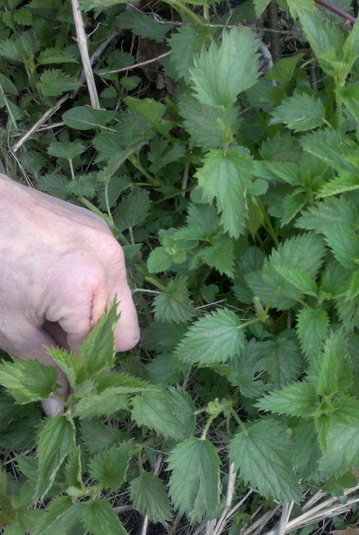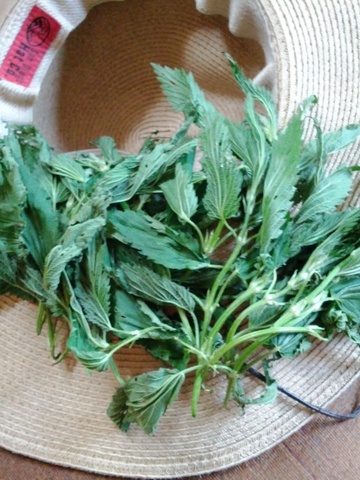Stinging nettles: Well worth the extra care for taste and nutrition

The stinging nettle can be picked barehanded, but gloves are recommended.
Linda Diane Feldt | Contributor
Stinging nettle, Urtica dioica, season is coming to an end already. This weekend will be a great time to look for nettles and bring them home to eat or preserve. Delivering significant amounts of iron, calcium and protein nettles are a welcome spring food. Here is where to find them, and how to use them.
I last wrote about nettles two years ago in a column called "Stinging nettle is early this year."
They continue to gain in popularity, and local foragers have been selling them at The People’s food Co-op and also the Farmer’s Market. Since they are carefully wild harvested and picked by hand, they command a high price. You can pay that or go out and find them on your own for free.
Nettles like areas with high nitrogen in the soil, as well as moisture. You can find them in the sun, as well as a more shaded forest setting. Look for them along river banks, at the site of old barns and enclosures (the animals will have supplied lots of nitrogen) but also randomly in forests and fence lines.
I created a couple nettle patches by transplanting some plants along the bank of a lake, and they moved themselves into a more shaded and protected area where the burdock also grows. By repeatedly picking the top third of the plant and the new shoots, I can extend the season a bit.
Once the flowers are beginning to form or the stems become stronger and not easily snapped, it’s time to stop picking it. It's also time to stop when the plant is more thinned out in its growth and over three feet in height. It doesn’t taste as good, and some people have reported stomach upset eating nettles later in the season. Certainly by June, most nettle should be left alone to flower.
This week I happened upon a nice patch of nettles while walking in the woods. This bit of land has just been purchased, and I was helping the new owners learn about the medicinal and edible plants they now had access to. Close to the end of our walk through this 20-some acre woods, we found the nettles right along the path. I carefully snapped off the top eight inches or so of each plants, using my hat as a container.

I collected some nettles in my hat, and by the next day they were beginning to dry out. But they were still okay to cook and enjoy!
Linda Diane Feldt | Contributor
I wasn’t stung at all, but my thumb and index finger felt the “buzz” from the formic acid present in the stinging hairs. Gloves are recommended for picking nettles and handling them when you get them home. Once the plant is either dried, mashed, or cooked, it can no longer sting.
Nettles have a bit of a chewy texture and taste far more interesting than spinach, and I always feel happy and excited when I eat them.
Use them right away
Fresh nettles can be lightly steamed (about 15-20 minutes), boiled as a pot green, featured in soups or used as you might spinach or kale. If you do boil or steam them, save the water from the pot and drink that as well. It will have lots of nutritional value. There have been a number of recipes circulated lately for nettle pesto. I’ve tried a couple of them, and they don’t make me happy at all. The nettle flavor is odd, almost muddy, and I think it is a waste of a great tasting plant. I don’t recommend that use at all.
Freeze them to eat later
Bring water to a boil, dip the nettles in until they change color (less than 30 seconds) place in a freezer container once they are cool enough and freeze. While they are best used within six months or so, I’ve found nettles in the back of the freezer from two years ago, and they were still edible, though they had clearly lost some flavor in the process.
Dry them for an herbal infusion
Spread the nettles out on a screen, or bundle and hang, until perfectly dry. Store in a jar with a lid out of direct sun. Use within a year. To make the infusion, bring water to a just below a boil, use about one inch of the dried and crushed nettle in a quart jar used for canning, pour in the water, put a lid on it, and steep for three to eight hours or overnight. Drain and enjoy hot or cold.
The infused plant material will help your compost pile, and is especially valued in biodynamic gardening. The infused nettle is a particularly effective way to use nettles medicinally.
Nettles have a long history of medicinal use
Regular use of the infusion can help to strengthen the lungs and kidneys, an extract made from the leaves is helpful for burns, eating the plant or using the infusion provides a good source of iron for anemia, and for allergies use of the extract or infusion seems to benefit some people as it may decrease the histamine response. There is ongoing research into using nettle for prostate disease.
The literature and research on nettles is accumulating, with documentation of a number of positive responses in varied use. The dangers of using nettles are few. Eating the plant is similar to eating most vegetables.
Using the extract and infusion is also considered safe, although as with any herb there are possible interactions with any drug you may be taking. It can have a diuretic effect for some people, and can lower blood sugar levels.
This is one of my favorite plants, and it grows abundantly in our area. Finding and harvesting stinging nettles would be a great reason to get outside and explore this weekend.
Linda Diane Feldt is a local holistic health practitioner, teacher and author. You can follow her on twitter, visit her website, or contact her directly. “Wildcrafting Recipes: Loving and Eating Wild Foods” is available as a weekly subscription, check here for more information on any of her six books. The next free class on herbal wisdom is May 24, and the subject is introducing kids to foraging. Check with the People’s Food Co-op for more information.

